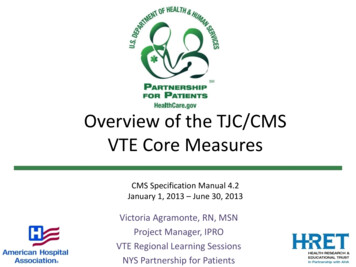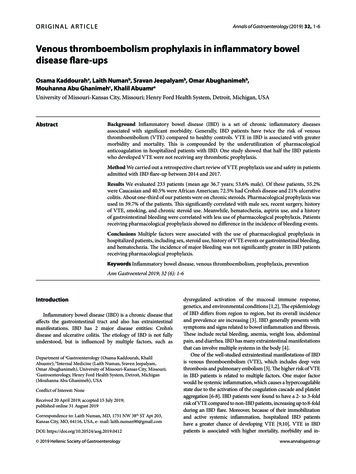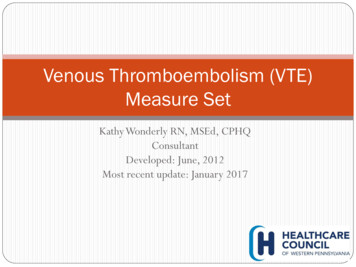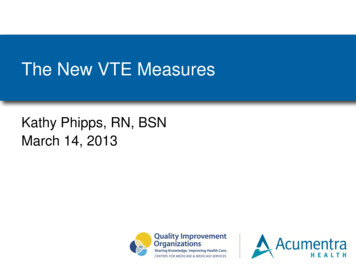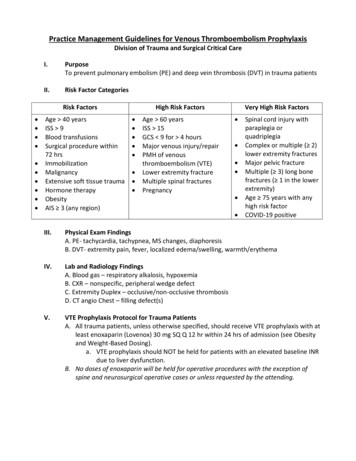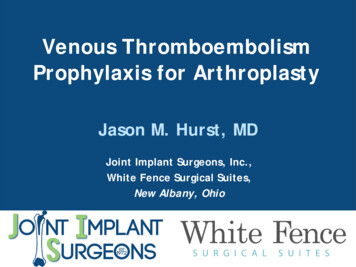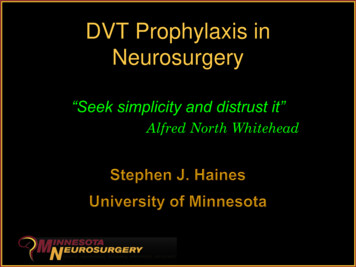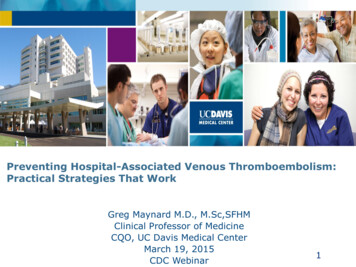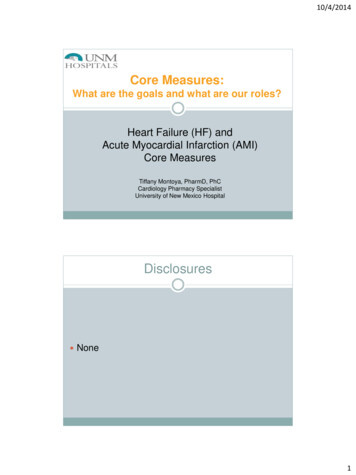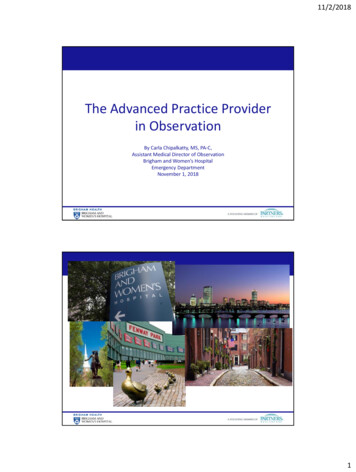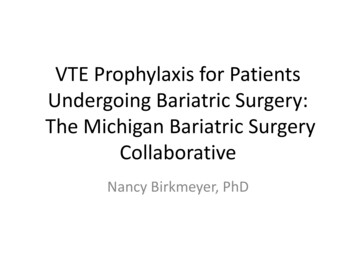
Transcription
VTE Prophylaxis for PatientsUndergoing Bariatric Surgery:The Michigan Bariatric SurgeryCollaborativeNancy Birkmeyer, PhD
What is the MBSC? Payer funded– Clinical outcomes registry– Quality improvement program Participants– Bariatric surgery programs throughout the state ofMichigan Coordination– Researchers at the UM
.21.22.23.24.25.26.Beaumont Grosse PointeBorgess Medical CenterBronson Medical CenterCrittenton Hospital and Medical CenterForest Health Medical CenterGratiot Medical CenterHarper University HospitalHenry Ford Bi-countyHenry Ford HospitalHenry Ford WyandotteHurley Medical CenterLakeland Community HospitalMarquette General HospitalMcLaren Regional Medical CenterMercy General Health PartnersMetro Health in WyomingMunson Medical CenterOakwood HospitalPort Huron HospitalSparrow Health SystemSpectrum Health SystemSt. John Hospital and Medical CenterSt. John OaklandSt. Mary Mercy HospitalSt. Mary's Grand RapidsUniversity of MI Health System
Purpose of the MBSC To improve the quality of care for patientsundergoing bariatric surgery in the State ofMichigan through regional collaboration in arobust clinical outcomes registry and qualityimprovement program.
Introduction The MBSC (2007-present)– 30 sites– 30,000 patients VTE– Incidence of VTE is 0.33%– Accounts for more than half of the deaths amongbariatric surgery patients
Outline Risk factorsIdentification of best practicesRisk stratified treatment guidelineResults to date
Risk Factors for VTERisk FactorOdds Ratio95% CIP-valueSleeve 20.001Age category1.271.04-1.560.017BMI category1.381.06-1.780.015Male sex2.081.34-3.220.001Any history of smoking1.390.91-2.130.130OR Time 3 hours2.241.28-3.890.004Prior history of VTE4.672.71-8.04 0.001Procedure (lap-band ref)
Rates of VTE According to VTEPredicted Risk Category76.06Percent543211.50.30Low(Predicted Risk 1%95% of patients)Medium(Predicted Risk 1-4%4% of patients)High(Predicted Risk 4%1% of patients)
Outline Risk factorsIdentification of best practicesRisk stratified treatment guidelineResults to date
VTE Prophylaxis Options Sequential compression devicesIn-hospital heparin/LMW heparinPost-discharge LMW heparinIVC filter
Variation in VTE Prophylaxis in 2007Sequential Compression DevicesIn-Hospital Heparin100%100%80%80%60%60%40%40%20%20%0%0%1 2 3 4 5 6 7 8 9 10 11 12 13 14 15 16 17 18 19 20 21 221 2 3 4 5 6 7 8 9 10 11 12 13 14 15 16 17 18 19 20 21 22SiteSitePost-Discharge HeparinIVC Filters100%100%80%80%60%60%40%40%20%20%0%0%1 2 3 4 5 6 7 8 9 10 11 12 13 14 15 16 17 18 19 20 21 221 2 3 4 5 6 7 8 9 10 11 12 13 14 15 16 17 18 19 20 21 22SiteSite
Rates* of VTE and Bleeding in Those Treated with InHospital LMW Heparin Compared to Those Treatedwith HeparinNoYes2.0P 0.00011.6Percent1.51.00.8p 0.0160.50.20.10.0VTE*BleedingAdjusted for procedure type, age, BMI, sex, smoking, procedure length 3 hours, and prior history of VTE.
Rates* of VTE and Bleeding in Patients Treated with andwithout Post-Discharge LMW HeparinOverallPercentNoMedium/High RiskYesNo3.53.53.03.02.52.52.0P 0.3761.51.2 1.11.0P 0.7040.50.2 0.2P 0.7803.23.0P edingAdjusted for procedure type, age, BMI, sex, smoking, procedure length 3 hours, and prior history of VTE.
Outline Risk factorsIdentification of best practicesRisk stratified treatment guidelineResults to date
VTE Risk-Stratified TreatmentGuideline Pocket Card Web-Based Instrument
VTE Pocket Card
Web-Based VTE Risk Calculator
Web-Based VTE Risk Calculator
Outline Risk factorsIdentification of best practicesRisk stratified treatment guidelineResults to date
PercentTemporal Trends in Rates of Use of InHospital LMW Heparin1009080706050403020100*p 0.00018084696062200720082009Time Period20102011Adjusted for procedure type, age, BMI, sex, smoking, procedure length 3 hours, and prior history of VTE.
Temporal Trends in Rates of Use ofPost-Discharge LMW HeparinPercentLow Risk454035302520151050Med/High Risk41393721212007200841192020092010Year*Adjusted for procedure type, age, BMI, sex, smoking, procedure length 3 hours, and prior history of VTE.
Temporal Trends* in the Use of IVCFilters76.46Percent54.2P ted for procedure type, age, BMI, sex, smoking, procedure length 3 hours, and prior history of VTE.
VTE Guideline Adherence Over Time8070p Adjusted for procedure type, age, BMI, sex, smoking, procedure length 3 hours, and prior history of VTE.
Variation in VTE Guideline Adherencein the Last Two Quarters by Site100%90%80%70%60%50%40%30%20%10%0%1 2 3 4 5 6 7 8 9 10 11 12 13 14 15 16 17 18 19 20 21 22 23 24 25 26 27 28Site
Temporal Trends* in Rates of VTE,Bleeding, and DeathVTEBleedingDeath1.4%p 0.3601.2%1.0%0.8%0.6%0.4%p 0.0080.2%p 0.0110.0%2007*200820092010Adjusted for procedure type, age, BMI, sex, smoking, mobility limitations, procedure length 3 hours, and prior history of VTE.
Barriers to Implementation Local, e.g.1. Surgeon thinks he will have increased rates ofbleeding if he gives his patients Lovenox2. Hospital administration thinks Lovenox is tooexpensive3. Surgeons want to treat all their bariatric patientswith post-discharge Lovenox
Conclusions Barriers are local No one size fits all solutions
-Bariatric surgery programs throughout the state of Michigan Coordination -Researchers at the UM . 1. Beaumont Grosse Pointe 2. Borgess Medical Center 3. Bronson Medical Center 4. Crittenton Hospital and Medical Center 5. Forest Health Medical Center 6. Gratiot Medical Center
